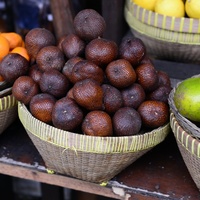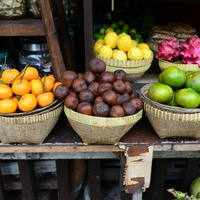Common name: Salak
Other common names: Dragon eggs, Salak, Snake fruit
Description
The Salaka is also refereed to as the snake fruit because of the scale like skin that encloses the fruit and seed. The fruit skin is brown in colour and grows in clusters on the plant. It is commonly 3 to 5 meters tall in cultivation, near trunk-less, with a central stem rarely reaching above 1 meter and upward arching leaves 3 to 5 meters long.
The fruit bunches emerging at ground level. There are usually ten to twenty fruit in a bunch
The fruit is very popular in Indonesia and to a lesser extent in Thailand and Malaysia.
Fruit size is around 2.5 cm in diameter
The ripe fruit is usually consumed fresh by cracking and peeling away the skin to reveal the fruit flesh. The flesh is in three segments, with the largest segment surrounding a brownish black seed, which is inedible.
The skin clings to the flesh, so peeling it off can be tedious. The flesh is sweet with a crisp texture and when fully ripe tastes like a blend of pineapple and banana.
A mature plant bears between 30 and 300 fruit per crop.
Most varieties are dioecious. However, the "Bali" variety is monoecious
[Edit]
Health use: The fruit are reportedly high in Calcium, Iron and Phosphorous



